This site uses cookies as defined in our Cookie Policy, by continuing to use this site you agree to their use.
Continue
| Arrive | Depart | ||||||
| 13th13 | OctOct | 202424 | Barcelona, Spain, embark on the Scarlet Lady | 18:00 | |||
| The infinite variety of street life, the nooks and crannies of the medieval Barri Gòtic, the ceramic tile and stained glass of Art Nouveau facades, the art and music, the throb of street life, the food (ah, the food!)—one way or another, Barcelona will find a way to get your full attention. The capital of Catalonia is a banquet for the senses, with its beguiling mix of ancient and modern architecture, tempting cafés and markets, and sun-drenched Mediterranean beaches. A stroll along La Rambla and through waterfront Barceloneta, as well as a tour of Gaudí's majestic Sagrada Famíliaand his other unique creations, are part of a visit to Spain's second-largest city. Modern art museums and chic shops call for attention, too. Barcelona's vibe stays lively well into the night, when you can linger over regional wine and cuisine at buzzing tapas bars. Barcelona, Spain With a home port only steps from Barcelona’s diverse neighborhoods and the famed urban beach of La Barceloneta, Sailors will uncover hidden secrets from local market cooking classes to modern and historic art in this vibrant seaside, architecturally stunning European city. | |||||||
| 14th14 | OctOct | 202424 | Cannes, France | 11:30 | |||
| Cannes is pampered with the luxurious year-round climate that has made it one of the most popular resorts in Europe. Cannes was an important sentinel site for the monks who established themselves on Île St-Honorat in the Middle Ages. Its bay served as nothing more than a fishing port until in 1834 an English aristocrat, Lord Brougham, fell in love with the site during an emergency stopover with a sick daughter. He had a home built here and returned every winter for a sun cure—a ritual quickly picked up by his peers. Between the popularity of Le Train Blue transporting wealthy passengers from Calais, and the introduction in 1936 of France's first paid holidays, Cannes became the destination, a tasteful and expensive breeding ground for the upper-upscale.Cannes has been further glamorized by the ongoing success of its annual film festival, as famous as Hollywood's Academy Awards. About the closest many of us will get to feeling like a film star is a stroll here along La Croisette, the iconic promenade that gracefully curves the wave-washed sand coastline, peppered with chic restaurants and prestigious private beaches. This is precisely the sort of place for which the French invented the verb flâner (to dawdle, saunter): strewn with palm trees and poseurs, its fancy boutiques and status-symbol grand hotels—including the Carlton, the legendary backdrop to Grace Kelly in To Catch a Thief —all vying for the custom of the Louis Vuitton set. This legend is, to many, the heart and soul of the Côte d'Azur. Cannes, France Famed for its annual star-studded international film festival, posh sunlounger-striped beaches, and massive yachts moored at the port, Cannes is one of the most glamorous cities in the French Riviera. A stroll down La Croisette, the town's long beach promenade, will lead you to numerous designer bars, couture stores, and fabulous hotels nestled in stunning old palaces. Make sure to have your camera ready at all times — not only is celeb-spotting a common pastime in Cannes, but the remarkable architecture and unparalleled natural beauty give the A-listers a run for their money. Spend a day at the beach where Borat's infamous mankini made its debut, watch the sunset at the romantic old quarter of Le Suquet, or dance the night away like the rich and famous did at oh-so many film premiere parties. The city is packed with a sense of duality — where historic, European streets filled with low-key restaurants meet moments (okay, weeks) of peak social glitz and glamour — giving you the opportunity to experience this French gem any way you so choose. This port may require Sailors to board a tender — it will both drop you off and pick you up from the ship to the port and vice versa. | |||||||
| 15th15 | OctOct | 202424 | Ajaccio, Corsica, France | 08:00 | |||
| Considered Corsica’s primary commercial and cultural hub, the largest city and regional capital of Ajaccio is situated on the west coast of the island, approximately 644 km (400 miles) southeast of Marseille, France. Founded in 1492, vestiges of ancient Corsica in this ville impériale revolve around the city’s most famous son, Napoléon Bonaparte, whose family home—now the national museum Maison Bonaparte—pays tribute to the emperor’s historical influence.Remnants from what was originally a 12th-century Genoese colony are still visible around the Old Town near the imposing citadel and watchtower. Perfect for exploring, the luminous seaside city surrounded by snowcapped mountains and pretty beaches offers numerous sites, eateries, side streets, and a popular harbor, where sailboats and fishing vessels moor in the picturesque Tino Rossi port lined with well-established restaurants and cafés serving fresh local fare. Ajaccio, France This French commune of the island of Corsica’s capital is filled with soaring mountains. Explore panoramic hiking trails, traverse Richiusa Canyon, try cafes in the historic center, or visit the home turned museum where Napoleon Bonaparte was born in 1769. Natural or crafted, art is everywhere. | |||||||
| 16th16 | OctOct | 202424 | Cagliari, Italy | 09:00 | |||
| Known in Sardinia as Casteddu, the island's capital has steep streets and impressive Italianate architecture, from modern to medieval. This city of nearly 160,000 people is characterized by a busy commercial center and waterfront with broad avenues and arched arcades, as well as by the typically narrow streets of the old hilltop citadel (called, simply, “Castello”). The Museo Archeologico makes a good starting point to a visit. The imposing Bastione di Saint Remy and Mercato di San Benedetto (one of the best fish markets in Italy) are both musts. Cagliari,Sardinia, Italy Among the most pristine beaches to be found in Europe, Cagliari is well known for its Hilltop Castello, a medieval walled quarter situated high over the rest of the town. Sailors can discover shipwrecks off the coast or stop by a local shepherd’s home for a farm-to-table meal in the countryside. | |||||||
| 17th17 | OctOct | 202424 | At Sea | ||||
| 18th18 | OctOct | 202424 | Catania, Italy | 09:00 | |||
| Catania is an ancient port city on Sicily's east coast. It sits at the foot of Mt. Etna, an active volcano with trails leading up to the summit. The city's wide central square, Piazza del Duomo, features the whimsical Fontana dell'Elefante statue and richly decorated Catania Cathedral. In the southwest corner of the square, La Pescheria weekday fish market is a rowdy spectacle surrounded by seafood restaurants. Catania, Sicily, Italy Hugely influential in the Renaissance era, mornings can be spent exploring the awe-inspiring architecture, while the youthful energy of the local shops and bars offer a vibrant afternoon. And with Mount Etna looming nearby, hiking the stratovolcano provides an earthy contrast to the bustling city. | |||||||
| 19th19 | OctOct | 202424 | Valletta, Malta | 09:00 | |||
| Malta's capital, the minicity of Valletta, has ornate palaces and museums protected by massive fortifications of honey-color limestone. Houses along the narrow streets have overhanging wooden balconies for people-watching from indoors. Generations ago they gave housebound women a window on the world of the street. The main entrance to town is through the City Gate (where all bus routes end), which leads onto Triq Repubblika (Republic Street), the spine of the grid-pattern city and the main shopping street. Triq Mercante (Merchant Street) parallels Repubblika to the east and is also good for strolling. From these two streets, cross streets descend toward the water; some are stepped. Valletta's compactness makes it ideal to explore on foot. City Gate and the upper part of Valletta are experiencing vast redevelopment that includes a new Parliament Building and open-air performance venue. The complex, completed mid-2013, has numerous pedestrian detours in place along with building noise and dust. Before setting out along Republic Street, stop at the tourist information office on Merchant Street for maps and brochures. Valletta, Malta A fortress city known for its cathedrals, sprawling gardens and museums it feels like you’re entering a different time when you step foot here – plus there’s no shortage of mystical blue lagoons and natural swimming pools to take a dip or explore. | |||||||
| 20th20 | OctOct | 202424 | At Sea | ||||
| 21st21 | OctOct | 202424 | Santorini, Greece | 08:00 | |||
| Undoubtedly the most extraordinary island in the Aegean, crescent-shape Santorini remains a mandatory stop on the Cycladic tourist route—even if it's necessary to enjoy the sensational sunsets from Ia, the fascinating excavations, and the dazzling white towns with a million other travelers. Called Kállisti (the "Loveliest") when first settled, the island has now reverted to its subsequent name of Thira, after the 9th-century-BC Dorian colonizer Thiras. The place is better known, however, these days as Santorini, a name derived from its patroness, St. Irene of Thessaloniki, the Byzantine empress who restored icons to Orthodoxy and died in 802. You can fly conveniently to Santorini, but to enjoy a true Santorini rite of passage, opt instead for the boat trip here, which provides a spectacular introduction. After the boat sails between Sikinos and Ios, your deck-side perch approaches two close islands with a passage between them. The bigger one on the left is Santorini, and the smaller on the right is Thirassia. Passing between them, you see the village of Ia adorning Santorini's northernmost cliff like a white geometric beehive. You are in the caldera (volcanic crater), one of the world's truly breathtaking sights: a demilune of cliffs rising 1,100 feet, with the white clusters of the towns of Fira and Ia perched along the top. The bay, once the high center of the island, is 1,300 feet in some places, so deep that when boats dock in Santorini's shabby little port of Athinios, they do not drop anchor. The encircling cliffs are the ancient rim of a still-active volcano, and you are sailing east across its flooded caldera. On your right are the Burnt isles, the White isle, and other volcanic remnants, all lined up as if some outsize display in a geology museum. Hephaestus's subterranean fires smolder still—the volcano erupted in 198 BC, about 735, and there was an earthquake in 1956. Indeed, Santorini and its four neighboring islets are the fragmentary remains of a larger landmass that exploded about 1600 BC: the volcano's core blew sky high, and the sea rushed into the abyss to create the great bay, which measures 10 km by 7 km (6 mi by 4½ mi) and is 1,292 feet deep. The other pieces of the rim, which broke off in later eruptions, are Thirassia, where a few hundred people live, and deserted little Aspronissi ("White isle"). In the center of the bay, black and uninhabited, two cones, the Burnt Isles of Palea Kameni and Nea Kameni, appeared between 1573 and 1925. There has been too much speculation about the identification of Santorini with the mythical Atlantis, mentioned in Egyptian papyri and by Plato (who says it's in the Atlantic), but myths are hard to pin down. This is not true of old arguments about whether tidal waves from Santorini's cataclysmic explosion destroyed Minoan civilization on Crete, 113 km (70 mi) away. The latest carbon-dating evidence, which points to a few years before 1600 BC for the eruption, clearly indicates that the Minoans outlasted the eruption by a couple of hundred years, but most probably in a weakened state. In fact, the island still endures hardships: since antiquity, Santorini has depended on rain collected in cisterns for drinking and irrigating—the well water is often brackish—and the serious shortage is alleviated by the importation of water. However, the volcanic soil also yields riches: small, intense tomatoes with tough skins used for tomato paste (good restaurants here serve them); the famous Santorini fava beans, which have a light, fresh taste; barley; wheat; and white-skin eggplants. Santorini, Greece As the Greek Goddess of the Cyclades Islands, Santorini is known for breathtaking panoramas, fiery orange and blue sunsets, and the famed red and black beaches. Take in views from the blue and white dotted hills of Oia, or enjoy locally-made wine while sailing along the waters of the Caldera coast. | |||||||
| 22nd22 | OctOct | 202424 | Khania, Greece | 09:00 | |||
| The second-largest city in Crete and capital of the Homonym Prefecture, Chania is located in Minoan Kidonia at the end of the Homonym Gulf between the Akrotiri and Onicha peninsulas. Chania City is divided into two parts; the Old Town, which is comprised of several connected districts built around the old Venetian Harbour, and New Town, a larger, more modern city whose centre is situated next to, and south of, the Old Town. The Old Town is home to Venetian buildings and Turkish elements that combine to create a unique architectural style, and is considered to be the most beautiful urban district on Crete. It was once surrounded by old Venetian fortifications that separated it from the New Town; however, only the eastern and western parts remain today. Due to its compact size, Skiathos can be easily explored in just a single day. Chania (Souda Bay), Crete, Greece As the largest of the Greek Isles, Crete makes you feel like time stands still. It’s a place where remnants of Venetian and Turkish architecture stand next to old townhouses transformed into hip restaurants, and glassy waters and swirls of pastel-pink sands make for beaches fit for postcards. | |||||||
| 23rd23 | OctOct | 202424 | Mykonos, Greece | 08:00 | |||
| Although the fishing boats still go out in good weather, Mykonos largely makes its living from tourism these days. The summer crowds have turned one of the poorest islands in Greece into one of the richest. Old Mykonians complain that their young, who have inherited stores where their grandfathers once sold eggs or wine, get so much rent that they have lost ambition, and in summer sit around pool bars at night with their friends, and hang out in Athens in winter when island life is less scintillating. Put firmly on the map by Jackie O in the 1960s, Mykonos town—called Hora by the locals—remains the Saint-Tropez of the Greek islands. The scenery is memorable, with its whitewashed streets, Little Venice, the Kato Myli ridge of windmills, and Kastro, the town's medieval quarter. Its cubical two- or three-story houses and churches, with their red or blue doors and domes and wooden balconies, have been long celebrated as some of the best examples of classic Cycladic architecture. Luckily, the Greek Archaeological Service decided to preserve the town, even when the Mykonians would have preferred to rebuild, and so the Old Town has been impressively preserved. Pink oleander, scarlet hibiscus, and trailing green pepper trees form a contrast amid the dazzling whiteness, whose frequent renewal with whitewash is required by law. Any visitor who has the pleasure of getting lost in its narrow streets (made all the narrower by the many outdoor stone staircases, which maximize housing space in the crowded village) will appreciate how its confusing layout was designed to foil pirates—if it was designed at all. After Mykonos fell under Turkish rule in 1537, the Ottomans allowed the islanders to arm their vessels against pirates, which had a contradictory effect: many of them found that raiding other islands was more profitable than tilling arid land. At the height of Aegean piracy, Mykonos was the principal headquarters of the corsair fleets—the place where pirates met their fellows, found willing women, and filled out their crews. Eventually the illicit activity evolved into a legitimate and thriving trade network. Morning on Mykonos town's main quay is busy with deliveries, visitors for the Delos boats, lazy breakfasters, and street cleaners dealing with the previous night's mess. In late morning the cruise-boat people arrive, and the shops are all open. In early afternoon, shaded outdoor tavernas are full of diners eating salads (Mykonos's produce is mostly imported); music is absent or kept low. In mid- and late afternoon, the town feels sleepy, since so many people are at the beach, on excursions, or sleeping in their air-conditioned rooms; even some tourist shops close for siesta. By sunset, people have come back from the beach, having taken their showers and rested. At night, the atmosphere in Mykonos ramps up. The cruise-boat people are mostly gone, coughing three-wheelers make no deliveries in the narrow streets, and everyone is dressed sexy for summer and starting to shimmy with the scene. Many shops stay open past midnight, the restaurants fill up, and the bars and discos make ice cubes as fast as they can. Ready to dive in? Begin your tour of Mykonos town (Hora) by starting out at its heart: Mando Mavrogenous Square. Mykonos, Greece Mykonos may be famous for its beach club parties and electric nightlife, but the Greek Isle has a notably quiet side, too. With overnight stays, you can explore the charm of the cafe-lined waterfront promenades, or tour the vineyards tucked charmingly into the gorgeous hillsides of the island. | |||||||
| 24th24 | OctOct | 202424 | Piraeus, Greece, disembark the Scarlet Lady | 06:30 | |||
| It's no wonder that all roads lead to the fascinating and maddening metropolis of Athens. Lift your eyes 200 feet above the city to the Parthenon, its honey-color marble columns rising from a massive limestone base, and you behold architectural perfection that has not been surpassed in 2,500 years. But, today, this shrine of classical form dominates a 21st-century boomtown. To experience Athens—Athína in Greek—fully is to understand the essence of Greece: ancient monuments surviving in a sea of cement, startling beauty amid the squalor, tradition juxtaposed with modernity. Locals depend on humor and flexibility to deal with the chaos; you should do the same. The rewards are immense. Although Athens covers a huge area, the major landmarks of the ancient Greek, Roman, and Byzantine periods are close to the modern city center. You can easily walk from the Acropolis to many other key sites, taking time to browse in shops and relax in cafés and tavernas along the way. From many quarters of the city you can glimpse "the glory that was Greece" in the form of the Acropolis looming above the horizon, but only by actually climbing that rocky precipice can you feel the impact of the ancient settlement. The Acropolis and Filopappou, two craggy hills sitting side by side; the ancient Agora (marketplace); and Kerameikos, the first cemetery, form the core of ancient and Roman Athens. Along the Unification of Archaeological Sites promenade, you can follow stone-paved, tree-lined walkways from site to site, undisturbed by traffic. Cars have also been banned or reduced in other streets in the historical center. In the National Archaeological Museum, vast numbers of artifacts illustrate the many millennia of Greek civilization; smaller museums such as the Goulandris Museum of Cycladic Art Museum and the Byzantine and Christian Museum illuminate the history of particular regions or periods. Athens may seem like one huge city, but it is really a conglomeration of neighborhoods with distinctive characters. The Eastern influences that prevailed during the 400-year rule of the Ottoman Empire are still evident in Monastiraki, the bazaar area near the foot of the Acropolis. On the northern slope of the Acropolis, stroll through Plaka (if possible by moonlight), an area of tranquil streets lined with renovated mansions, to get the flavor of the 19th-century's gracious lifestyle. The narrow lanes of Anafiotika, a section of Plaka, thread past tiny churches and small, color-washed houses with wooden upper stories, recalling a Cycladic island village. In this maze of winding streets, vestiges of the older city are everywhere: crumbling stairways lined with festive tavernas; dank cellars filled with wine vats; occasionally a court or diminutive garden, enclosed within high walls and filled with magnolia trees and the flaming trumpet-shaped flowers of hibiscus bushes. Formerly run-down old quarters, such as Thission, Gazi and Psirri, popular nightlife areas filled with bars and mezedopoleia (similar to tapas bars), are now in the process of gentrification, although they still retain much of their original charm, as does the colorful produce and meat market on Athinas. The area around Syntagma Square, the tourist hub, and Omonia Square, the commercial heart of the city about 1 km (½ mi) northwest, is distinctly European, having been designed by the court architects of King Otho, a Bavarian, in the 19th century. The chic shops and bistros of ritzy Kolonaki nestle at the foot of Mt. Lycabettus, Athens's highest hill (909 feet). Each of Athens's outlying suburbs has a distinctive character: in the north is wealthy, tree-lined Kifissia, once a summer resort for aristocratic Athenians, and in the south and southeast lie Glyfada, Voula, and Vouliagmeni, with their sandy beaches, seaside bars, and lively summer nightlife. Just beyond the city's southern fringes is Piraeus, a bustling port city of waterside fish tavernas and Saronic Gulf views. Piraeus (Athens), Greece Few cities are as colorful as Athens — from the street art scene to the bright blue skies and sand-fringed shores. Take in breathtaking views from the Mikrolimano Marina, immerse yourself in ancient Greek history at the Parthenon, and explore the Acropolis; which remains the heart of the city. | |||||||
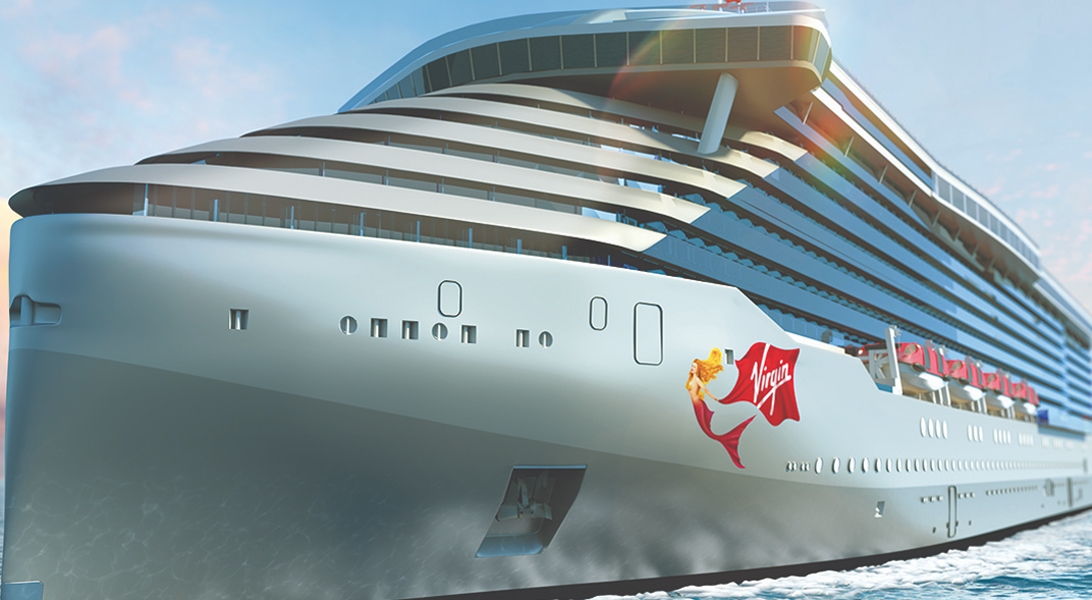













The images shown are for illustration purposes only and may not be an exact representation of what you find on the ship.
The images shown are for illustration purposes only and may not be an exact representation of what you find on the ship.
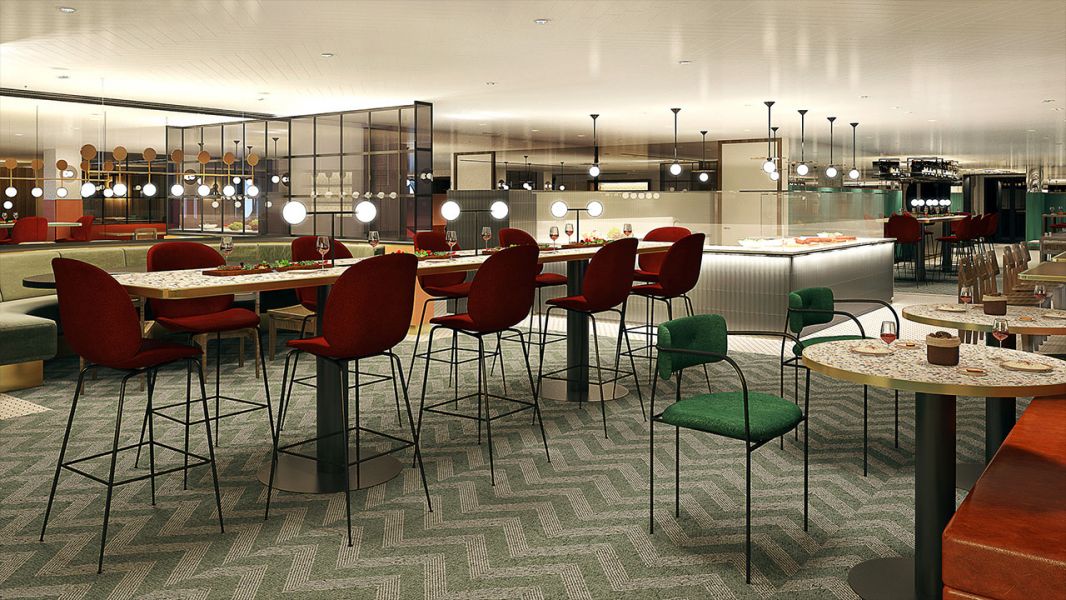
Deeply rooted in Italian culinary traditions, the trattoria serves regionally-inspired food punctuated by our fresh, handmade pasta. Start with antipasti - this selection of cured meats and cheeses gets Sailors’ mouths watering for more. While everyone loves a good pizza, Extra Virgin focusses on pasta-centric favorites made fresh daily. Match with a great Italian wine and top it off with traditional aperitivos and digestivos to make their night complete...or help it get started.
FEATURES
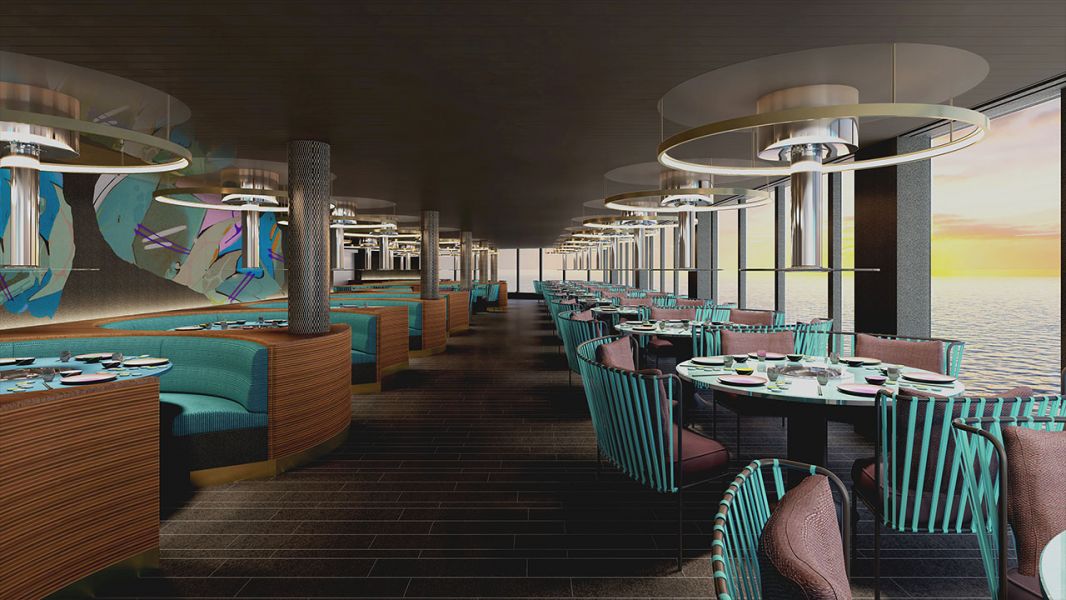
If you're into hands-on meat-grilling and soju drinking, the Korean BBQ is the perfect spot. Sailors have the option to choose from meats, seafood, vegetables, or all of the above when they’re ready to start grilling and our crew will be on hand to help. Virgin Voyages specially designed a flameless grill for the ultimate BBQ experience, which will be the centerpiece of the loudest restaurant at sea.
FEATURES
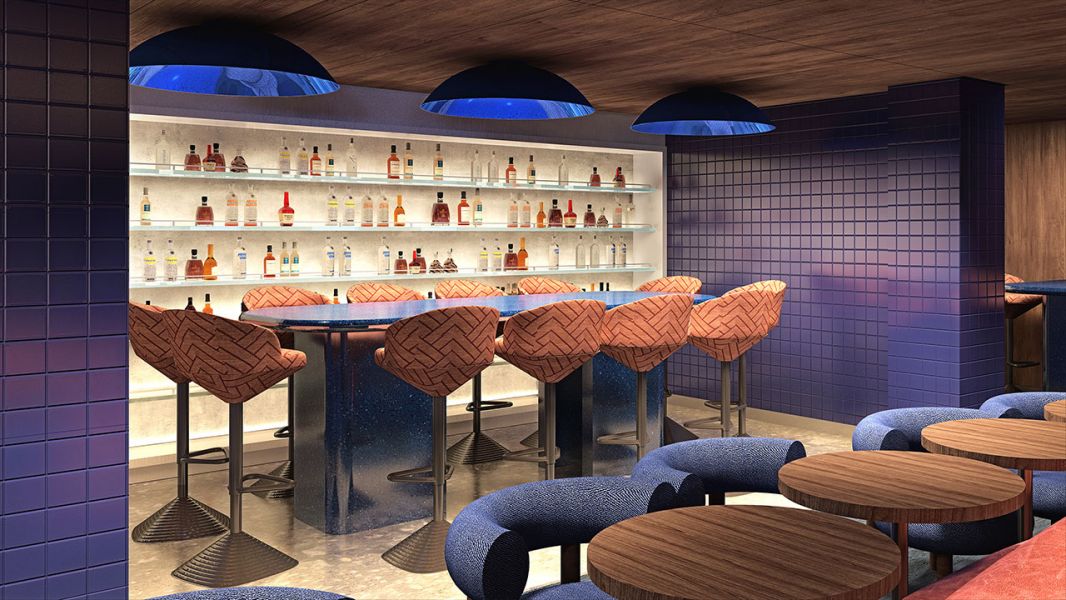
Inspired by the vibrant, colorful streets of Mexico, Sailors are treated to a menu reflecting the regions emerging culinary renaissance. Personal, intimate, and educational, our mezcalier will guide you through a highly curated dining and drinking experience. Pink Agave is our tribute to sophisticated Mexican Cuisine, and home to our impressive mezcal and tequila collection.
FEATURES
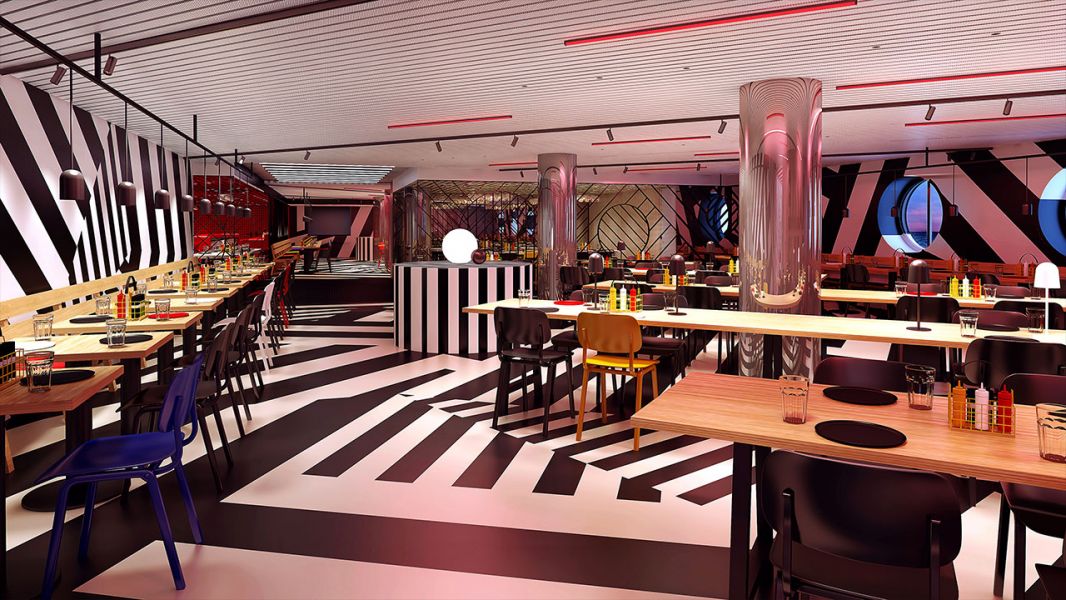
One of our most unique offerings onboard, Razzle Dazzle Restaurant is a veggie-forward eatery that delivers a healthy dose of nice with just the right amount of naughty. Sailors can choose from one side that skews towards plant-based vegetarian and vegan dishes including must have munchies such as the Impossible Burger, or the indulgent side – meaty cheats, sweets and gluttonous treats. Sailors can enjoy healthy smoothies and juices by day and the retox with signature cocktails by night in a lively, bustling environment.
FEATURES
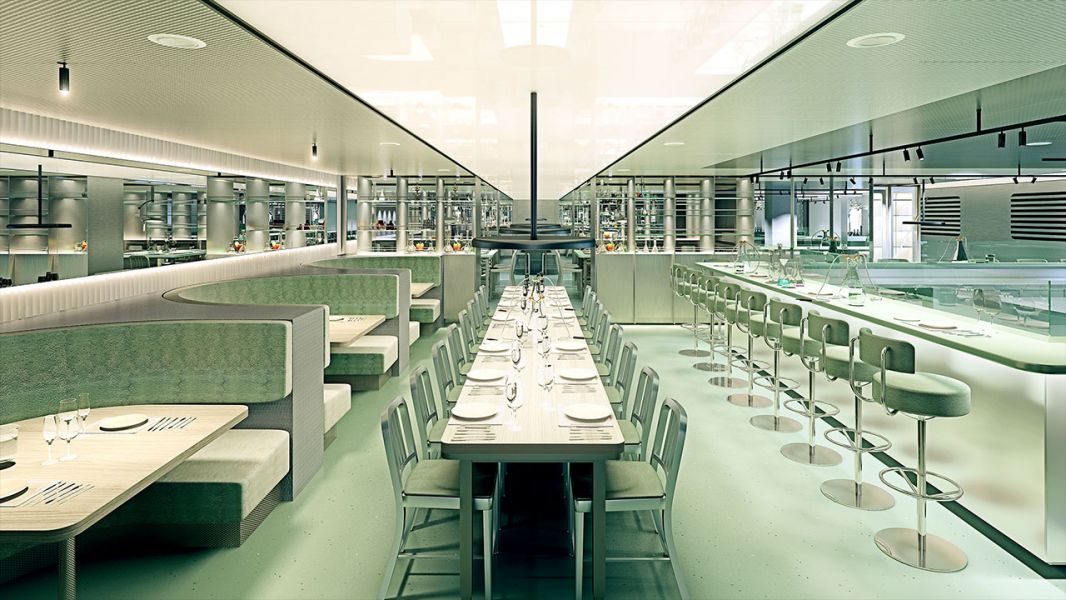
The Test Kitchen is the most unique, innovative, and experimental dining experience on ship. The tasting menu is presented in the form of an ingredient list where Sailors put their trust into our expert chefs to make the decisions. This laboratory-like eatery is part cooking school and part restaurant. It's educational, experiential and delicious in ways you’ve never tasted. With classes and evolving tasting menus, this is for the curious, boundary-pushing tastebuds on board.
FEATURES
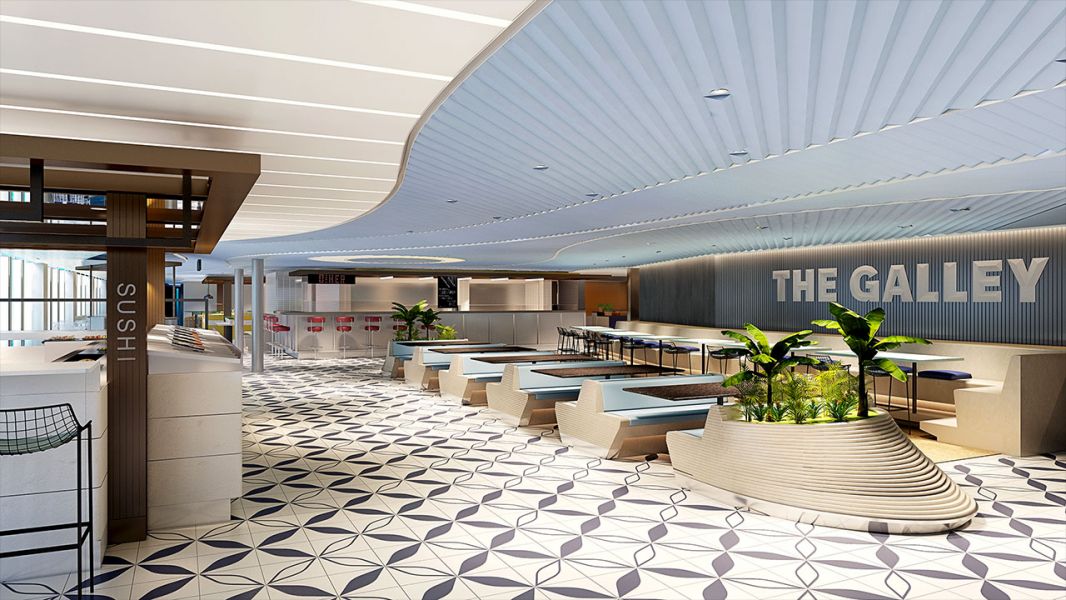
Modeled after popular food halls where you can taste a variety of options - The Galley, designed by Softroom - is your go-to for a quick bite, meal or pick-me-up throughout the day. Featuring a mix of more than eight shops and food-truck style carts, each spot will have a unique concept with signature dishes that change to suit the time of day. The Galley (takes a deep breath before reading an impressively long list) boasts a dedicated bakery and pastry shop, a panini shop, a burger grill, a taco shack, a sushi bar with bento boxes, a noodle bar, a soup and salad stand, and a 24-hour American diner. And exhale.
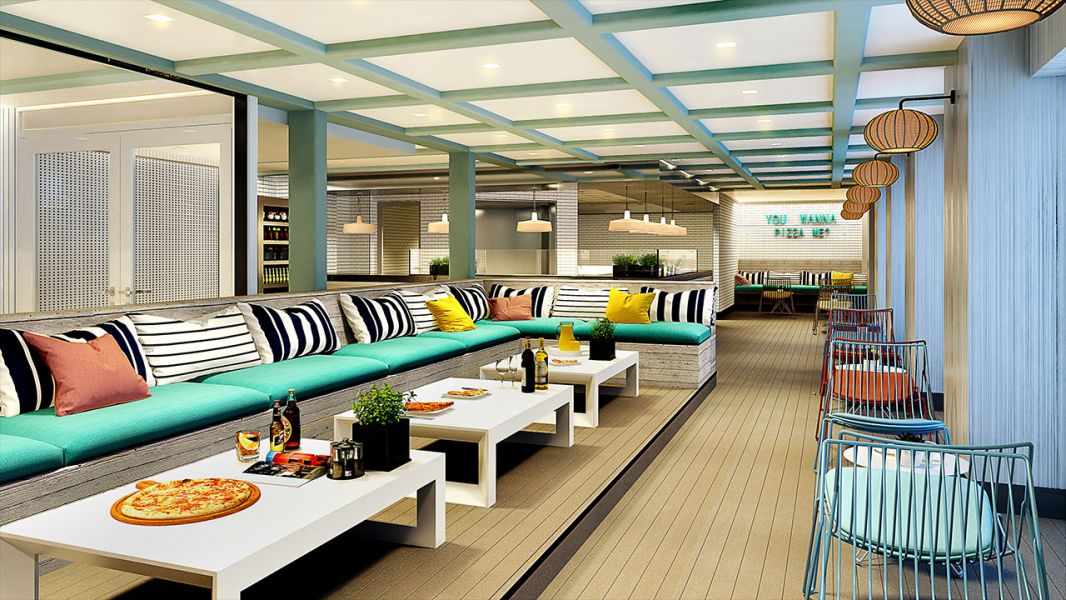
No pre-cooked pizza slices sitting under warming lamps here. Sailors can choose from the classic menu or design their very own bespoke pizza. Featuring a brilliant beach club inspired design with white and pastel colored furniture, navy striped accent pillows and hammocks for lounging, this casual spot is a perfect lunch time destination or late-night, post drink, hunger buster go-to.
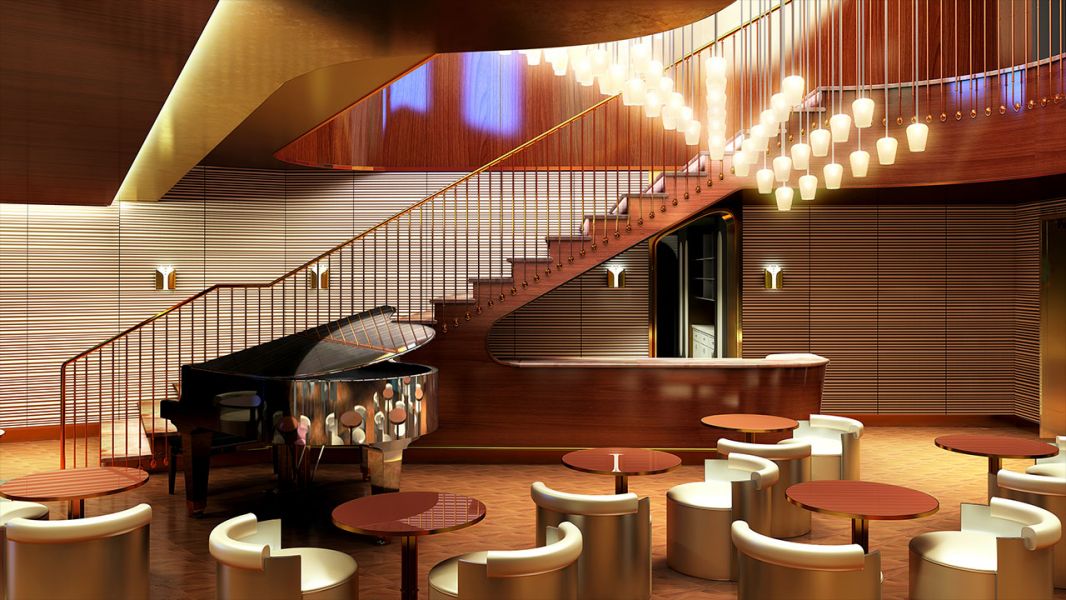
The perfect mix of sophistication, nostalgia and cool - entering The Wake is an event in itself. As soon as they see the grand staircase, Sailors will feel like they’ve stumbled onto a glitz & glam movie set that is regal by design with raised levels of luxury and exuberance.
FEATURES
The images shown are for illustration purposes only and may not be an exact representation of what you find on the ship.
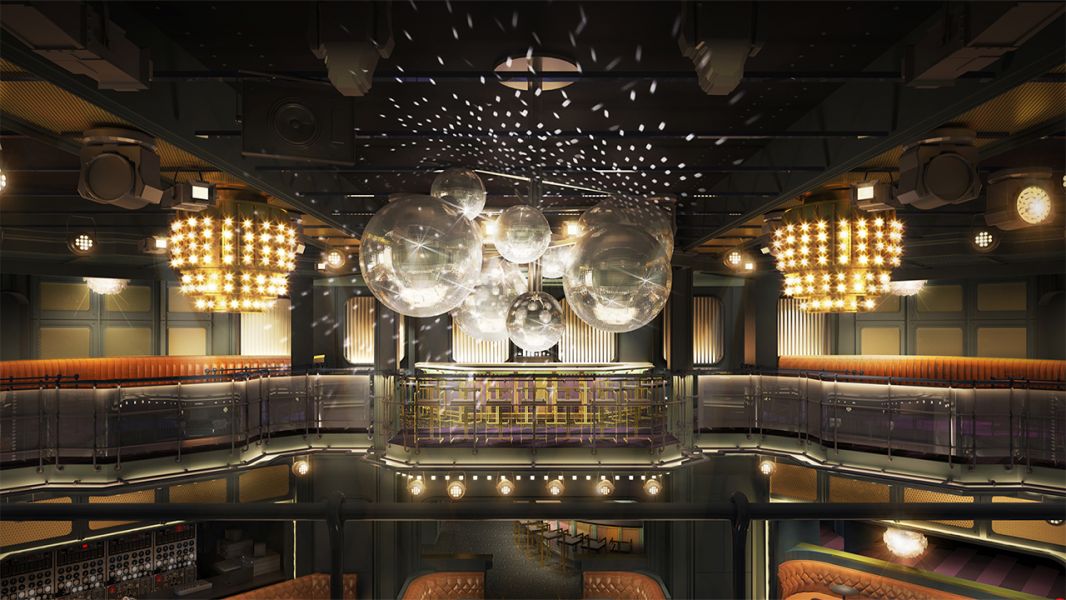
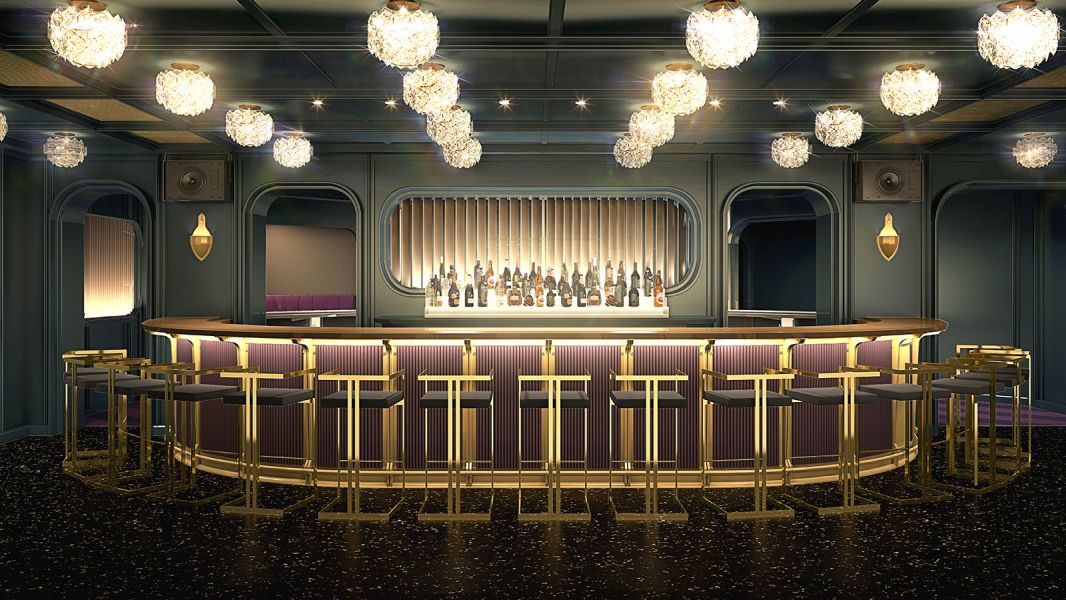
Alluring Nightclub
This kick ass, two story, two bar space, named after Richard's first recording studio, is inspired by the coolest clubs on land layered with a moody and sexy 70’s punk vibe. The Manor will host a ground-breaking, immersive dining entertainment experience (coming soon), to kick the night off before it transitions into a mind-blowing, goodbye-early-morning-workout nightclub.
The images shown are for illustration purposes only and may not be an exact representation of what you find on the ship.
The images shown are for illustration purposes only and may not be an exact representation of what you find on the ship.
| 11 nights aboard the Scarlet Lady | |||
| Exclusively Adults Only | |||
| Eat in any of the 20 eateries On-Board. It's all included | |||
| Gratuities Included in the Price | |||
| Choice of Original Music Gigs and Events | |||
| Unlimited Wi-Fi | |||
| All Fitness Classes Included | |||
| Free Tea, Coffee, Water and Sodas | |||
| Free 24 Hour Room Service | |||
| Port Taxes and Fees | |||
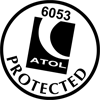 | ABTA and ATOL Protection* | ||
Date 13th Oct 2024 |
Nts 11 |
Interior £2,258pp |
Oceanview £2,447pp |
Balcony £2,687pp |
Suite £12,035pp |
Date 13th Oct 2024 |
Nts 11 |
Interior £2,258pp |
Oceanview £2,447pp |
Balcony £2,687pp |
Suite £12,035pp |
| Interior staterooms from | £2,258pp | ||
| I4 | Social Insider | £2,258pp | |
| IN | The Insider | £4,610pp | |
| I1 | Solo Insider | £4,294pp | |
| Oceanview staterooms from | £2,447pp | ||
| VZ | The Sea View (Guarantee Cabin) | £2,447pp | |
| V1 | Solo Sea View | £4,724pp | |
| Balcony staterooms from | £2,687pp | ||
| TZ | The Sea Terrace (Guarantee Cabin) | £2,687pp | |
| TL | Limited View Sea Terrace | £2,783pp | |
| TC | Central Sea Terrace | £2,821pp | |
| Suite staterooms from | £12,035pp | ||
| SP | Posh Suite | £12,035pp | |
Fusion Cruises when selling travel arrangements is a trading name of The Midcounties Co-operative Ltd. Fusion Cruises is an Accredited Body Member of Midcounties Co-operative Travel Consortium. (ABTA:P6652, ATOL:6053).
Book with Confidence. We are a Member of ABTA which means you have the benefit of ABTA’s assistance and Code of Conduct.
Some of the flights and flight-inclusive holidays on this website are financially protected by the ATOL scheme but ATOL protection does not apply to all holiday and travel services offered on this website. This website will provide you with information on the protection that applies in the case of each holiday and travel service offered before you make your booking. If you do not receive an ATOL Certificate then the booking will not be ATOL protected. If you do receive an ATOL Certificate but all parts of your trip are not listed on it, those parts will not be ATOL protected. Please see our booking conditions for information, or for more information about financial protection and the ATOL Certificate go to: www.caa.co.uk
